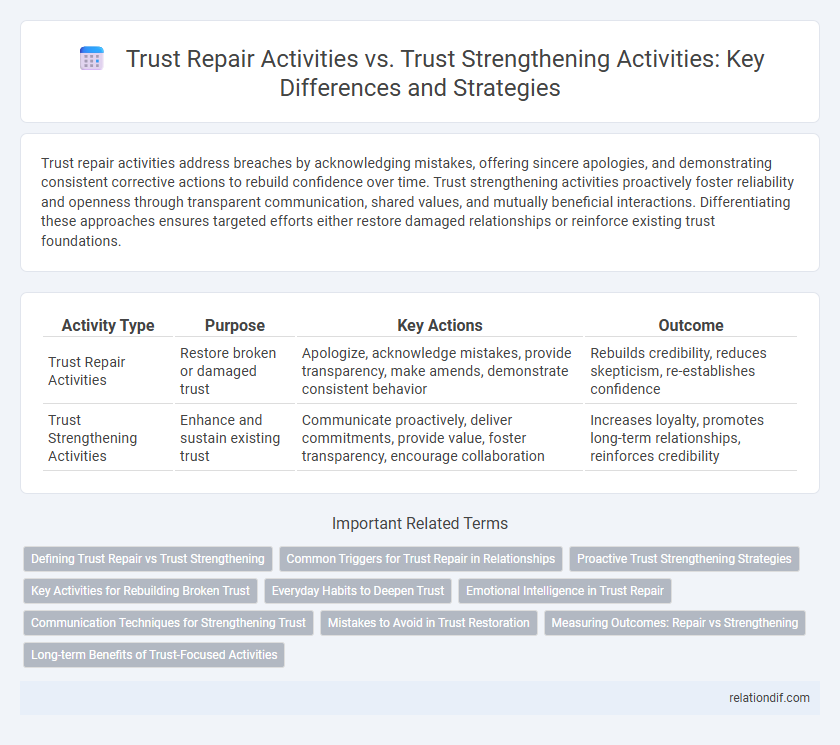Trust repair activities address breaches by acknowledging mistakes, offering sincere apologies, and demonstrating consistent corrective actions to rebuild confidence over time. Trust strengthening activities proactively foster reliability and openness through transparent communication, shared values, and mutually beneficial interactions. Differentiating these approaches ensures targeted efforts either restore damaged relationships or reinforce existing trust foundations.
Table of Comparison
| Activity Type | Purpose | Key Actions | Outcome |
|---|---|---|---|
| Trust Repair Activities | Restore broken or damaged trust | Apologize, acknowledge mistakes, provide transparency, make amends, demonstrate consistent behavior | Rebuilds credibility, reduces skepticism, re-establishes confidence |
| Trust Strengthening Activities | Enhance and sustain existing trust | Communicate proactively, deliver commitments, provide value, foster transparency, encourage collaboration | Increases loyalty, promotes long-term relationships, reinforces credibility |
Defining Trust Repair vs Trust Strengthening
Trust repair involves actions aimed at restoring trust after it has been damaged, focusing on acknowledging breaches, offering sincere apologies, and implementing corrective measures to rebuild confidence. Trust strengthening, by contrast, emphasizes proactive behaviors that enhance existing trust through consistent reliability, transparent communication, and demonstrating competence over time. Defining these concepts clarifies that trust repair targets recovery from violations, while trust strengthening seeks to maintain and deepen ongoing trust relationships.
Common Triggers for Trust Repair in Relationships
Common triggers for trust repair in relationships include breaches such as dishonesty, unmet expectations, and breaches of confidentiality, which cause emotional hurt and doubt. Trust repair activities focus on acknowledgment of wrongdoing, sincere apologies, and consistent actions to rebuild integrity and credibility. Trust strengthening activities emphasize ongoing transparency, reliable communication, and mutual respect to prevent future violations and foster resilience in the relationship.
Proactive Trust Strengthening Strategies
Proactive trust strengthening strategies focus on consistent transparent communication, reliable performance, and shared values to build a resilient foundation before breaches occur. These activities include regular feedback loops, collaborative goal setting, and fostering emotional connections that preemptively mitigate misunderstandings. Emphasizing trust strength through ongoing positive interactions reduces the need for trust repair, which is typically reactive and resource-intensive.
Key Activities for Rebuilding Broken Trust
Trust repair activities focus on addressing breaches through transparent communication, sincere apologies, and consistent corrective actions to demonstrate accountability. Key trust strengthening activities include reinforcing reliability and predictability by meeting commitments and enhancing relational transparency over time. Effective trust repair prioritizes immediate acknowledgment of harm and actionable steps to restore confidence, differentiating it from ongoing trust-building efforts aimed at resilience and durability.
Everyday Habits to Deepen Trust
Everyday trust repair activities involve consistent apologies, transparent communication, and active listening to address misunderstandings and rebuild confidence. Trust strengthening activities focus on proactive behaviors such as reliability, honesty, and empathy to reinforce positive relationships over time. Integrating these habits regularly helps deepen trust by balancing restoration efforts with ongoing commitment to mutual respect and integrity.
Emotional Intelligence in Trust Repair
Emotional intelligence plays a crucial role in trust repair activities by enabling individuals to recognize, understand, and manage emotions during conflict resolution, which helps rebuild damaged relationships effectively. Trust repair often requires empathic communication, active listening, and genuine apologies to address emotional wounds, while trust strengthening activities focus on consistent, reliable behaviors that reinforce trust over time. High emotional intelligence facilitates both repairing trust after breaches and strengthening it proactively by fostering open, transparent interactions and emotional attunement.
Communication Techniques for Strengthening Trust
Effective communication techniques for strengthening trust include consistent transparency, active listening, and timely feedback, which foster openness and reliability in relationships. Employing clear, empathetic messaging while addressing concerns promptly enhances mutual understanding and reinforces credibility. Regular, honest dialogue helps maintain trust resilience by preventing misunderstandings and demonstrating commitment to shared goals.
Mistakes to Avoid in Trust Restoration
Avoid rushing the process when engaging in trust repair activities, as premature apologies or insincere gestures can further damage credibility. Refrain from minimizing the breach or deflecting responsibility, since acknowledging faults transparently is crucial for genuine restoration. Neglecting consistent follow-through on commitments undermines efforts to rebuild trust, emphasizing the importance of reliability and accountability in trust strengthening activities.
Measuring Outcomes: Repair vs Strengthening
Measuring outcomes in trust repair activities often involves assessing the restoration of credibility through metrics like apology acceptance rates, conflict resolution success, and subsequent behavior changes. Trust strengthening activities emphasize ongoing evaluation of relational resilience using indicators such as increased transparency, consistent communication quality, and long-term satisfaction surveys. Quantitative data from trust repair tends to focus on immediate recovery, whereas trust strengthening metrics capture sustained mutual confidence and proactive trust building.
Long-term Benefits of Trust-Focused Activities
Trust repair activities address breaches and rebuild damaged relationships through acknowledgment and corrective actions, restoring confidence over time. Trust strengthening activities proactively nurture and reinforce positive interactions, fostering resilience and deepening relational bonds. Sustained trust-focused efforts contribute to long-term benefits such as increased collaboration, enhanced loyalty, and improved organizational performance.
Trust Repair Activities vs Trust Strengthening Activities Infographic

 relationdif.com
relationdif.com